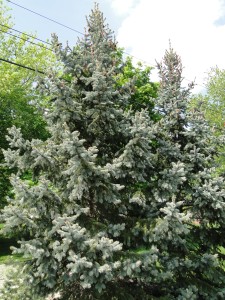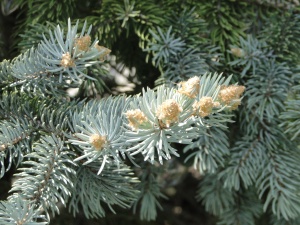Commonly planted for its bright blue foliage, Colorado Blue Spruce are very cold hardy conifers that typically grow in a compact shape. Many cultivars exist for this popular screen ornamental tree, and all of them grow fairly slowly. These spruces are also subject to many pests and diseases, which often prevents these trees from reaching an old age.
Picea pungens (Colorado Blue Spruce)
Deciduous: no
Hardiness Zones: 2-7
Height: 9-18 meters (30-60 feet) tall in cultivation, up to 30 meters (100 feet) tall in native habitats, largest reported
at 38 meters (126 feet) tall with a 154 centimeter (61 inches) diameter trunk at breast height (d.b.h.) in Colorado
Diameter: 3-6 meters (10-20 feet) wide
Growth Rate: slow, especially when young (some 2 year saplings may reach 15 centimeters (6 inches) tall, some 5 year
saplings may reach 50-60 centimeters (20-24 inches) tall)
Age: Seed production begins at around 20 years old and maxes out between 50 and 150 years old. Under good conditions,
these may live to be 600 years old.
Root System: Shallow, first year saplings may have roots around 6 centimeters (2.5 inces) deep.
Family: Pinaceae
Subspecies: ‘Argentea’ (silvery-white foliage), ‘Aurea’ (golden-yellow foliage), ‘Bakeri’ (bluish light, longer needles),
‘Caerulea’ (blue-white foliage), ‘Compacta’ (compact, flat dwarf), ‘Fat Albert’ (a popular favorite), ‘Glauca’ (bluish-
green, serves as name for any with this type of foliage), ‘Glauca Pendula’ (pendulous, sickle-shaped), ‘Hoopsii’ (dense,
pyrimidal), ‘Hunnewelliana’ (dull green foliage, dense, pyrimidal, dwarf), ‘Koster’ (more horizontal branches, pendulous,
blue-white to silver-white foliage), ‘Moerheimi’ (primidal, compact, deep blue foliage), Thomsen’ (pyrimidal silver-blue
foliage, longer needles), ‘Viridis’ (bland green)
Tolerates: herbivores (deer, rabbits), drought (once mature and established), strong winds, urban pollution
Problems (major):Western Spruce Budworm larva (Choristoneura occidentalis), damping-off (Phytophthora cinnamomi
responsible for), cylindrocladium root rot (Cylindrocladium scoparium), Nematodes, Snow molds, Root lesion nematode
(Pratylenchus penetrans), Cankers (Leucocytospora kunzei/Cytospora kunzei responsible for), Western spruce dwarf mistletoe (Arceuthobium microcarpum), Common kinnikinnik (Arctostaphylos uva-ursi), Root rot (Armillaria mellea and Inonotus tomentosus), Heart rot (Phellinus pini and Fomitopsis pinicola and Climacocystis borealis and Polyporus caesius),
Budworms, Bagworms, Spider Mites
Problems (minor): Spruce seed calchid (Megastimus piceae), Spruce seed moth larva (Laspeyresia youngana), Cone cochylid (Henriscus fuscodorsana), Spruce coneworm larva (Dioryctria reniculelloides), Spruce needle miner (Taniva abolineana), Needle Miner (Coleotechnites piceaella ), Cooley spruce gall aphid (Adelges cooleyi), Pine leaf aphids (Pineus pinifoliae and P. similis), Green spruce aphid (Cinara fornacula and C. coloradensis), White pine weevil (Pissodes strobi), Twig beetles (Pityophthorus spp.), Spruce beetle (Dendroctonus rufipennis), Engraver beetle (Ips pilifrons), Dryocoetes
affaer, Four-eyed spruce beetle (Polygraphus rufipennis), Ambrosia beetles (Gnathotrichus sulcatus and Trypodendron
bivattatum), Golden buprestid (Buprestis aurulenta), Rust (Chrysomyxa pirolata), Tip blight (Phomopsis occulta), Needle
rots and prematurely shedding needles (3 Chrysomyxa species), Needle cast fungus (Rhizosphaera kalkhoffii), Perennial
yellow witche’s broom (Chrysomyxa arctostaphyli),
Poisonous: no
Soil requirements: prefers acidic, moist, well-drained soils, tolerates light/sandy and medium/loamy and heavy/clay
Air requirements: tolerant of poor air quality
Watering requirement: moderate, tolerates some drought when well established
Sun requirement: full sun to partial shade (when young, before cone production)
Needles: green-blue to silver-blue, to 4 centimeters (1.5 inches) long, stiff, point in all directions
Cones (male): grow in whorls of 3 to 5, present in upper half of mature trees, terminal, pollen dispersed may to June
Cones (female): grow in the upper quarter of mature trees, terminal, initially green, bright red when receptive and erect,
light brown at maturity and facing down, around 200 scales, up to 400 seeds per cone, to 10 centimeters (4 inches) long
Seeds: light brown, winged, rarely disperse 90 meters (300 feet) from the cone on the parent tree, prolific yields every 2
or 3 years under good conditions
Germination: occurs in late spring to early summer
Saplings: require moist soil, although they can survive short dry periods
Grafting: reported to be successful
Vegetative reproduction: not reported
Form: pyrimidal
Bark: gray to red, small scales
Seeds require stratification: not necessary for germination
Monoecious or Dioecious: monoecious
Leaves: none
Flowers: none
Fruits: none
Notable characteristics:
Blue Spruce naturally grown in fairly moist, acidic soils at high altitudes ranging from 5,000 feet to 11,000 feet above
sea levels.
Uses:
These conifers are grown mostly for their ornamental or aesthetic value.
Sources used:
- http://www.na.fs.fed.us/pubs/silvics_manual/Volume_1/picea/pungens.htm
- http://www.missouribotanicalgarden.org/PlantFinder/PlantFinderDetails.aspx?kempercode=c226
- http://plants.usda.gov/core/profile?symbol=PIPU
- http://dendro.cnre.vt.edu/dendrology/syllabus/factsheet.cfm?ID=109
- http://www.pfaf.org/user/Plant.aspx?LatinName=Picea+pungens
Shape
New, fertile female cones ready for fertilization in May
New foliage emerging from winter buds
P. pungens ‘Colorado Blue’ has very light-blue foliage
P. pungens ‘Montgomery’
All of the images provided were taken by me; they may be used for educational or informational purposes provided that this online journal or article is appropriately cited first.





